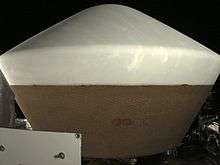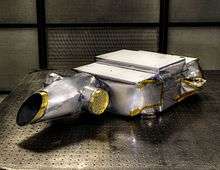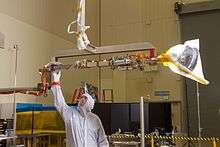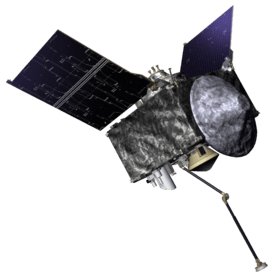OSIRIS-REx
|
Artist's rendering of the OSIRIS-REx spacecraft | |||||||||||||||
| Names | Origins, Spectral Interpretation, Resource Identification, Security, Regolith Explorer | ||||||||||||||
|---|---|---|---|---|---|---|---|---|---|---|---|---|---|---|---|
| Mission type | Asteroid sample return[1] | ||||||||||||||
| Operator | NASA | ||||||||||||||
| COSPAR ID | 2016-055A | ||||||||||||||
| SATCAT № | 41757 | ||||||||||||||
| Website |
asteroidmission | ||||||||||||||
| Mission duration |
Planned: 7 years 505 days at asteroid Elapsed: 2 months, 26 days, 20 hours | ||||||||||||||
| Spacecraft properties | |||||||||||||||
| Manufacturer | Lockheed Martin | ||||||||||||||
| Launch mass | 2,110 kg (4,650 lb)[2] | ||||||||||||||
| Dry mass | 880 kg (1,940 lb)[2] | ||||||||||||||
| Dimensions | 2.44 × 2.44 × 3.15 m (8 × 8 × 10.33 ft)[2] | ||||||||||||||
| Power | 1,226 to 3,000 W[2] | ||||||||||||||
| Start of mission | |||||||||||||||
| Launch date | 8 September 2016, 23:05 UTC[3] | ||||||||||||||
| Rocket | Atlas V 411, AV-067[3] | ||||||||||||||
| Launch site | Cape Canaveral SLC-41 | ||||||||||||||
| Contractor | United Launch Alliance | ||||||||||||||
| End of mission | |||||||||||||||
| Landing date | Planned: 24 September 2023, 15:00 UTC[4] | ||||||||||||||
| Landing site | Utah Test and Training Range[4] | ||||||||||||||
| Flyby of Earth | |||||||||||||||
| Closest approach | 22 September 2017[2] | ||||||||||||||
| 101955 Bennu orbiter | |||||||||||||||
| Orbital insertion | August 2018[4] | ||||||||||||||
| Departed orbit | March 2021[2] | ||||||||||||||
| Sample mass | 0.1–2.0 kg (0.13–4.4 lb)[4] | ||||||||||||||
| |||||||||||||||
|
| |||||||||||||||
The Origins, Spectral Interpretation, Resource Identification, Security, Regolith Explorer (OSIRIS-REx) is a NASA asteroid study and sample return mission.[5][6][7][8] The launch occurred on 8 September 2016. Its mission is to study asteroid 101955 Bennu, a carbonaceous asteroid, and return a sample to Earth in 2023 for detailed analysis. The material returned is expected to enable scientists to learn more about the formation and evolution of the Solar System, its initial stages of planet formation, and the source of organic compounds that led to the formation of life on Earth.[9] If successful, OSIRIS-REx will be the first US spacecraft to return samples from an asteroid.
The cost of the mission will be approximately US$800 million[10] not including the Atlas V launch vehicle, which is about US$183.5 million.[11] It is the third planetary science mission selected in the New Frontiers program, after Juno and New Horizons. The Principal Investigator is Dante Lauretta from the University of Arizona.
Mission

Overall management, engineering and navigation for the mission is provided by NASA's Goddard Space Flight Center, while the University of Arizona's Lunar and Planetary Laboratory provides principle science operations and Lockheed Martin Space Systems built the spacecraft and provides mission operations.[2] The science team includes members from the United States, Canada, France, Germany, United Kingdom, and Italy.[12]
After traveling for approximately two years, the spacecraft is to rendezvous with asteroid 101955 Bennu in 2018 and begin 505 days of surface mapping at a distance of approximately 5 km (3.1 mi).[1] Results of that mapping will be used by the mission team to select the site from which to take a sample of the asteroid's surface.[13] Then a close approach (without landing) will be attempted to allow extension of a robotic arm to gather the sample.[14]
An asteroid was chosen as the target of study because an asteroid is a 'time capsule' from the birth of our Solar System.[15] In particular, 101955 Bennu was selected because of the availability of pristine carbonaceous material, a key element in organic molecules necessary for life as well as representative of matter from before the formation of Earth. Organic molecules, such as amino acids, have previously been found in meteorite and comet samples, indicating that some ingredients necessary for life can be naturally synthesized in outer space.[1]
Following collection of material (from 60 grams to two kilograms) in July 2020, the sample will be returned to Earth in a 46-kilogram (101 lb) capsule similar to that which returned the samples of comet 81P/Wild on the Stardust spacecraft. The return trip to Earth will be shorter, and will land with a parachute at the Utah Test and Training Range in September 2023. The capsule will then be transported to the Johnson Space Center for processing in a dedicated research facility.[1]
The acronym OSIRIS was chosen in reference to the ancient mythological Egyptian god Osiris, the underworld lord of the dead. He was classically depicted as a green-skinned man with a pharaoh's beard, partially mummy-wrapped at the legs and wearing a distinctive crown with two large ostrich feathers at either side.[16] Rex means 'king' in Latin. His name was chosen for this mission as asteroid Bennu is a threatening Earth impactor capable of causing vast destruction and death.[16][17]
Launch

The launch was on 8 September 2016 at 23:05 UTC on a United Launch Alliance Atlas V 411 from Cape Canaveral Space Launch Complex 41.[3] The 411 rocket configuration consists of a RD-180 powered first stage with a single AJ-60A solid fuel booster, and a Centaur upper stage.[18] OSIRIS-REx separated from the launch vehicle 55 minutes after ignition,[2] with a speed of 5.4 km/s (12,000 mph).[19] The launch was declared "exactly perfect" by the mission's Principal Investigator, with no anomalies worked before or during launch.[20]
Cruise
OSIRIS-REx entered the cruise phase shortly after separation from the launch vehicle, following successful solar panel deployment, propulsion system initiation, and establishment of a communication link with Earth.[20] Its hyperbolic escape speed from Earth was about 5.41 km/s. Starting in January 2017, near aphelion, the spacecraft will use onboard thrusters to change velocity by 520 m/s and thereby bring about an Earth flyby in September 2017 to increase its heliocentric speed and increase its orbital inclination to 6°.[21] The cruise phase will last until August 2018, when the spacecraft will encounter Bennu and begin the science and sample collection part of the mission.
Sample acquisition

During an extensive remote sensing campaign, a sample site will be chosen and rehearsals will be performed for the final sampling event. The solar arrays will be raised into a Y-shaped configuration to minimize the chance of dust accumulation during contact and provide more ground clearance in case the spacecraft tips over (up to 45°) during contact.[12] The descent will be very slow in order to minimize thruster firings prior to contact in order to reduce the likelihood of asteroid surface contamination by unreacted hydrazine propellant. Contact with the surface of Bennu will be detected using accelerometers, and the impact force will be dissipated by a spring in the TAGSAM arm.
Upon surface contact by the TAGSAM instrument, a burst of nitrogen gas will be released, which will blow regolith particles smaller than 2 cm into the sampler head located at the end of the robotic arm. A five-second timer will limit collection time to mitigate the chance of a collision. After the timer expires the back-away maneuver will initiate a safe departure from the asteroid.[12] The spacecraft will then halt the drift away from the asteroid in case it is necessary to return for another sampling attempt. The spacecraft will use images and spinning maneuvers to verify the sample has been acquired as well as determine its mass and verify it is in excess of the required 60 grams.[12] In the event of a failed sampling attempt, the spacecraft will return for another try. There is enough nitrogen gas for three attempts.[2]
In addition to the bulk sampling mechanism, contact pads on the end of the sampling head will passively collect dust grains smaller than 1 mm, upon contact with the asteroid. These pads are made from tiny loops of stainless steel.[22]
After the sampling attempt, the Sample Return Capsule (SRC) lid will be opened to allow the sampler head to be stowed. The arm will be retracted into the launch configuration and the SRC lid will be closed and latched for the return to Earth.
Science objectives

The science objectives of the mission are:[23]
- Return and analyze a sample of pristine carbonaceous asteroid regolith in an amount sufficient to study the nature, history, and distribution of its constituent minerals and organic material.
- Map the global properties, chemistry, and mineralogy of a primitive carbonaceous asteroid to characterize its geologic and dynamic history and provide context for the returned samples.
- Document the texture, morphology, geochemistry, and spectral properties of the regolith at the sampling site in situ at scales down to millimeters.
- Measure the Yarkovsky effect (a thermal force on the object) on a potentially hazardous asteroid and constrain the asteroid properties that contribute to this effect.
- Characterize the integrated global properties of a primitive carbonaceous asteroid to allow for direct comparison with ground-based telescopic data of the entire asteroid population.
.png)
Telescopic observations have helped define the orbit of 101955 Bennu, a near-Earth object with a mean diameter in the range of 480 to 511 metres (1,575 to 1,677 ft).[24] It completes an orbit of the Sun every 436.604 days (1.2 years). This orbit takes it close to the Earth every six years. Although the orbit is reasonably well known, scientists continue to refine it. It is critical to know the orbit of Bennu because recent calculations produced a cumulative probability of 1 in 1410 (or 0.071%) of impact with Earth in the period 2169 to 2199.[25] Part of the OSIRIS-REx mission is to refine understanding of non-gravitational effects (such as the Yarkovsky effect) on this orbit, and the implications of those effects for Bennu's collision probability. Knowing Bennu's physical properties will be critical for future scientists to know when developing an asteroid impact avoidance mission.[19]
Telescopic observations have revealed some basic properties of Bennu. They indicate that it is very dark and is classified as a B-type asteroid, a sub-type of the carbonaceous C-type asteroids. Such asteroids are considered "primitive", having undergone little geological change from their time of formation.
Specifications
- Dimensions: Length 2.4 m (8 ft), width 2.4 m (8 ft), height 3.1 m (10.33 ft)[2]
- Width with solar arrays deployed: 6.2 m (20.25 ft)[2]
- Power: Two solar arrays generate 1226–3000 watts, depending on the spacecraft's distance from the Sun. Energy is stored in Li-ion batteries.[2]
- Propulsion system: Based on a hydrazine monopropellant system developed for the Mars Reconnaissance Orbiter, carrying 1,230 kg (2,710 lb) of propellant and helium.[26]
- The Sample Return Capsule (SRC) will re-enter the Earth's atmosphere for a parachute assisted landing. The capsule with encased samples will be retrieved from Earth's surface and studied, as was done with the Stardust mission.
Payload

In addition to its telecommunication equipment, the spacecraft will carry a suite of instruments that will study the asteroid in many wavelengths,[27] as well as image the asteroid, and retrieve a physical sample to return to Earth. The Planetary Society coordinated a campaign to invite interested persons to have their names or artwork on the mission's spirit of exploration saved on a microchip to be carried in the spacecraft.[28][29]
OCAMS
The OSIRIS-REx Camera Suite (OCAMS) consists of the PolyCam, the MapCam, and the SamCam.[30] Together they acquire information on asteroid Bennu by providing global mapping, sample site reconnaissance and characterization, high-resolution imaging, and records of the sample acquisition.[31]
- PolyCam, an 8-inch (20 cm) telescope, acquires images with increasingly higher resolution as the spacecraft approaches the asteroid.
- MapCam searches for satellites and outgassing plumes. It maps the asteroid in 4 different colors, informs our model of Bennu's shape and provides high resolution imaging of the sample-site.
- SamCam continuously documents the sample acquisitions.
OLA
The OSIRIS-REx Laser Altimeter (OLA) is a scanning and LIDAR instrument that will provide high resolution topographical information throughout the mission.[30] The information received by OLA will create global topographic maps of Bennu, local maps of candidate sample sites, ranging in support of other instruments, and support navigation and gravity analyses.
OLA will scan the surface of Bennu at specific intervals in the mission to rapidly map the entire surface of the asteroid to achieve its primary objective of producing local and global topographic maps. The data collected by OLA will also be used to develop a control network relative to the center of mass of the asteroid and to enhance and refine gravitational studies of Bennu.
OLA has a single common receiver and two complementary transmitter assemblies that enhance the resolution of the information brought back. OLA's high-energy laser transmitter is used for ranging and mapping from 1 to 7.5 km (0.6 to 4.7 mi). The low-energy transmitter is used for ranging and imaging from 0.5 to 1 km (0.3 to 0.6 mi). The repetition rate of these transmitters sets the data acquisition rate of OLA. Laser pulses from both the low and high energy transmitters are directed onto a movable scanning mirror, which is co-aligned with the field of view of the receiver telescope limiting the effects of background solar radiation. Each pulse provides target range, azimuth, elevation, received intensity and a time-tag.
OLA is funded by the Canadian Space Agency (CSA) and was built by MacDonald, Dettwiler and Associates at Brampton, Ontario, Canada.[32] OLA was delivered for integration with the spacecraft on 17 November 2015.[33][34]
OVIRS

The OSIRIS-REx Visible and IR Spectrometer (OVIRS) is a spectrometer, which measures light to provide mineral and organic spectral maps and local spectral information of candidate sample sites.[30] It also provides full-disc asteroid spectral data, global spectral maps (20 m resolution), and spectra of the sample site (blue to near-infrared, 400–4300 nm, with a spectral resolution of 7.5–22 nm).[35] These data will be used in concert with OTES spectra to guide sample-site selection. These spectral ranges and resolving powers are sufficient to provide surface maps of mineralogical and molecular components including carbonates, silicates, sulfates, oxides, adsorbed water and a wide range of organic compounds. It provides at least two spectral samples per resolution element taking full advantage of the spectral resolution.
OTES
The OSIRIS-REx Thermal Emission Spectrometer (OTES) provides mineral and thermal emission spectral maps and local spectral information of candidate sample sites by collecting thermal infrared data from 4–50 µm.[30]
OTES provides full-disc Bennu spectral data, global spectral maps, and local sample site spectral information used to characterize the global, regional, and local mineralogic composition and thermal emission from the asteroid surface. The wavelength range, spectral resolution, and radiometric performance are sufficient to resolve and identify the key vibrational absorption features of silicate, carbonate, sulfate, phosphate, oxide, and hydroxide minerals. OTES is also used to measure the total thermal emission from Bennu in support of the requirement to measure emitted radiation globally. Based on the performance of Mini-TES in the dusty surface environment of Mars, OTES is expected to be resilient to extreme dust contamination on the optical elements.
REXIS
The Regolith X-ray Imaging Spectrometer (REXIS) will provide an X-ray spectroscopy map of Bennu, complementing core OSIRIS-REx mission science.[30] REXIS is a collaborative development by four groups within Massachusetts Institute of Technology (MIT) and Harvard University, with the potential to involve more than 100 students throughout the process. REXIS is based on flight heritage hardware, thereby minimizing elements of technical risk, schedule risk, and cost risk.
REXIS is a coded aperture soft X-ray (0.3–7.5 keV) telescope that images X-ray fluorescence line emission produced by the interaction of solar X-rays and the solar wind with the regolith of Bennu. Images are formed with 21 arcminute resolution (4.3 m spatial resolution at a distance of 700 m). Imaging is achieved by correlating the detected X-ray image with a 64 x 64 element random mask (1.536 mm pixels). REXIS will store each X-ray event data in order to maximize the data storage usage and to minimize the risk. The pixels will be addressed in 64 x 64 bins and the 0.3–7.5 keV range will be covered by five broad bands and 11 narrow line bands. A 24 s resolution time tag will be interleaved with the event data to account for Bennu rotation. Images will be reconstructed on the ground after downlink of the event list. Images are formed simultaneously in 16 energy bands centered on the dominant lines of abundant surface elements from O-K (0.5 keV) to Fe-Kß (7 keV) as well the representative continuum. During orbital phase 5B, a 21-day orbit 700 m from the surface of Bennu, a total of at least 133 events/asteroid pixel/energy band are expected under 2 keV; enough to obtain significant constraints on element abundances at scales larger than 10 m.
TAGSAM

The sample return system, called Touch-And-Go Sample Acquisition Mechanism (TAGSAM), consists of a sampler head with an articulated 3.35-metre (11 ft) arm.[2][30] An on-board nitrogen source will support up to three separate sampling attempts for a minimum total amount of 60 grams (2.1 oz) of sample. The surface contact pads will also collect fine-grained material.
Highlights of the TAGSAM instrument and technique include:
- Slowly approach surface at 0.2 metres per second (0.66 ft/s),[36]
- Contact within 25 metres (82 ft) of selected location,
- OCAMS documents sampling at 1 Hz,
- Collect samples in less than five seconds, direct nitrogen (N2) annular jet fluidizes regolith, surface-contact pad captures surface sample,
- Verify bulk sample collection via spacecraft inertia change; surface sample by imaging sampler head,
- Sampler head stored in Sample Return Capsule (SRC) and returned to Earth.
OSIRIS-REx II
OSIRIS-REx II was a 2012 proposal to replicate the original spacecraft for a double mission, with the second vehicle collecting samples from the two moons of Mars, Phobos and Deimos. It was stated that this mission would be both the quickest and least expensive way to get samples from the moons.[37][38]
See also
References
- 1 2 3 4 Brown, Dwayne C. (25 May 2011). "NASA To Launch New Science Mission To Asteroid In 2016". NASA. Retrieved 18 September 2016.
- 1 2 3 4 5 6 7 8 9 10 11 12 13 "OSIRIS-REx: Asteroid Sample Return Mission" (PDF) (Press Kit). NASA. August 2016. Retrieved 18 September 2016.
- 1 2 3 Graham, William (8 September 2016). "Atlas V begins OSIRIS-REx's round trip to the asteroid Bennu". NASA Spaceflight. Retrieved 18 September 2016.
- 1 2 3 4 Ray, Justin (9 September 2016). "OSIRIS-REx probe launched to asteroid in compelling search for the origins of life". Astronomy Now. Retrieved 18 September 2016.
- ↑ Brown, Dwayne; Neal-Jones, Nancy (31 March 2015). "RELEASE 15-056 - NASA's OSIRIS-REx Mission Passes Critical Milestone". NASA. Retrieved 4 April 2015.
- ↑ Chang, Kenneth (5 September 2016). "NASA Aims at an Asteroid Holding Clues to the Solar System's Roots". New York Times. Retrieved 6 September 2016.
- ↑ Corum, Jonathan (8 September 2016). "NASA Launches the Osiris-Rex Spacecraft to Asteroid Bennu". New York Times. Retrieved 9 September 2016.
- ↑ Chang, Kenneth (8 September 2016). "The Osiris-Rex Spacecraft Begins Chasing an Asteroid". New York Times. Retrieved 9 September 2016.
- ↑ "OSIRIS-REx Mission Selected for Concept Development". Goddard Space Flight Center.
- ↑ "NASA Aims to Grab Asteroid Dust in 2020". Science Magazine. 26 May 2011.
- ↑ Buck, Joshua; Diller, George (5 August 2013). "NASA Selects Launch Services Contract for OSIRIS-REx Mission". NASA. Retrieved 8 September 2013.
- 1 2 3 4 Kramer, Herbert J. "OSIRIS-REx". Earth Observation Portal Directory. Retrieved 20 April 2015.
- ↑ "NASA Successfully Launch OSIRIS-REx Asteroid Mission". borntoengineer.com. 9 September 2016. Retrieved 9 September 2016.
- ↑ "UA gets $1.2M to aid in asteroid mission". Tucson Citizen. 26 May 2011.
- ↑ Next Stop, Bennu! NASA Launches Bold Asteroid-Sampling Mission. Mike Wall, Space.com. 8 September 2016.
- 1 2 Wolchover, Natalie (27 May 2011). "NASAcronyms: How OSIRIS-REx Got Its Name". LiveScience. Retrieved 12 May 2015.
- ↑ Moskowitz, Clara (30 May 2011). "The OSIRIS REX: NASA Chooses Threatening Asteroid for New Mission". Space.com. Retrieved 12 May 2015.
- ↑ Atlas V begins OSIRIS-REx's round trip to the asteroid Bennu. 8 September 2016. William Graham.
- 1 2 OSIRIS REx, The Mission.
- 1 2 Wall, Mike. "'Exactly Perfect'! NASA Hails Asteroid Sample-Return Mission's Launch". Space.com. Retrieved 10 September 2016.
- ↑ "OSIRIS-REx Mission & Trajectory Design". Spaceflight101.com. Sep 2016. (McAfee WebAdvisor warns that this site contains content from potentially dangerous or suspicious sites.)
- ↑ Lauretta, Dante. "How Do We know When We Have Collected a Sample of Bennu?". Life on the Asteroid Frontier. Retrieved 23 August 2016.
- ↑ OSIRIS-Rex Infosheet (PDF)
- ↑ "Physical properties of OSIRIS-REx target asteroid (101955) 1999 RQ36. Derived from Herschel, VLT/ VISIR, and Spitzer observations.". December 2012.
- ↑ "Earth Impact Risk Summary for 101955 Bennu". Near Earth Object Program. NASA's JPL. 5 August 2010. Retrieved 29 April 2013.
- ↑ Lauretta, Dante (16 December 2014). "Integration of the OSIRIS-REx Main Propellant Tank". Dslauretta.com. Retrieved 20 April 2015.
- ↑ "Instruments - OSIRIS-REx Mission". Retrieved 14 September 2016.
- ↑ "NASA Invites Public to Send Artwork to an Asteroid". NASA. 19 February 2016. Retrieved 1 April 2016.
- ↑ "OSIRIS-REx". planetary.org. Retrieved 10 September 2016.
- 1 2 3 4 5 6 "Instruments: Science Payload". University of Arizona. Retrieved 18 September 2016.
- ↑ "OCAMS – The Eyes of OSIRIS-REx". dslauretta.com. 11 January 2014. Retrieved 10 September 2016.
- ↑ "OLA, Canada's Contribution to OSIRIS-REx". Canadian Space Agency (CSA). 4 March 2013. Retrieved 15 October 2014.
- ↑ Canada Contributes to NASA’s OSIRIS-REx Mission. NASA News. 17 July 2014.
- ↑ Canada to Invest in Space Exploration with New Laser. "Kelowna Now". 17 November 2015.
- ↑ Simon-Miller, A. A.; Reuter, D. C. (2013). OSIRIS-REx OVIRS: A Scalable Visible to Near-IR Spectrometer for Planetary Study (PDF). 44th Lunar and Planetary Science Conference. 18-22 March 2013. The Woodlands, Texas. Bibcode:2013LPI....44.1100S.
- ↑ "How To Get To Bennu and Back". dslauretta.com. 27 November 2013. Retrieved 10 September 2016.
- ↑ Elifritz, T. L. (2012). OSIRIS-REx II to Mars - Mars Sample Return from Phobos and Deimos (PDF). Concepts and Approaches for Mars Exploration. 12-14 June 2012. Houston, Texas. Bibcode:2012LPICo1679.4017E.
- ↑ Templeton, Graham (31 May 2016). "OSIRIS-REx is about to go collect (and return) samples from an asteroid". ExtremeTech. Retrieved 24 November 2016.
External links
| Wikimedia Commons has media related to OSIRIS-REx. |
- OSIRIS-REx website by NASA
- OSIRIS-REx website by the University of Arizona

.png)





.jpg)
